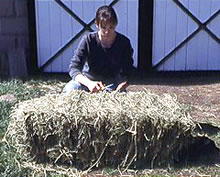![]()
![]()
![]()
![]()
![]()
![]()

![]()
![]()
![]()
![]()
![]()
How to Test Your Horse's Hay
Follow these five steps to test your horse's
hay and screen for harmful bales.
Bad hay is more than unappetizing for your
horse. Moldy, dusty or spoiled roughage can trigger
respiratory allergies or colic in horses. Buying your hay
from a reputable supplier reduces your chances of getting an
unacceptable lot, but an occasional bad bale can slip into
any shipment.
To screen out potentially harmful hay, give
each bale you feed the following five tests. Failing any one
means the bale is moldy or otherwise spoiled and needs to go
straight to the compost heap.
The bounce test:
Drop the bale from waist level or higher. Acceptable hay has
some spring and bounces when it hits the ground.
The bend test:
Pick up the bale by the twine. A good bale has some
flexibility and sags a bit when you lift it. The degree of
sag depends upon how tightly pressed the hay was during
baling.
The "poof" test:
When you release the twine, good-quality hay "poofs" out and
expands because of its springiness.
The color test:
Any shade of green is a hallmark of good hay. Yellow or
brown hay is sunburned and, while generally safe, probably
has lost some nutrients along with the color change. Gray or
black coloring is grounds for immediate rejection.
The sniff test:
Take a close-up whiff. Good hay smells sweet and grassy,
without the slightest hint of breath-catching mold or dust.
This article originally appeared in the March
2000 issue of EQUUS magazine. To find out how to find the
best forage for your horses, read "Buy Hay with Confidence"
in the August 2005 issue of EQUUS magazine.
|
![]()
![]()
ęCopyright 2025
Alhaja.net All rights reserved.
Unauthorized duplication in part or whole strictly prohibited by
international copyright law.
![]()




